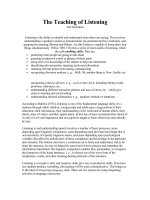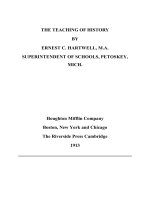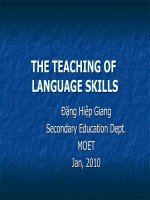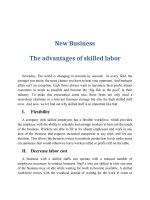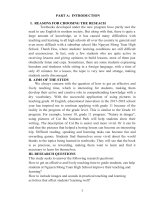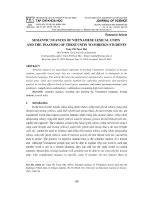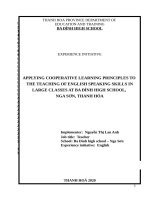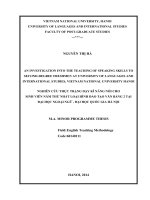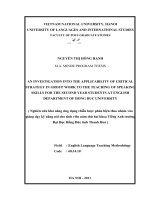the teaching of skill
Bạn đang xem bản rút gọn của tài liệu. Xem và tải ngay bản đầy đủ của tài liệu tại đây (142.89 KB, 23 trang )
THE TEACHING OF
THE TEACHING OF
LANGUAGE SKILLS
LANGUAGE SKILLS
Đặng Hiệp Giang
Đặng Hiệp Giang
Secondary Education Dept.
Secondary Education Dept.
MOET
MOET
Jan, 2010
Jan, 2010
Learning Styles and
Learning Styles and
Strategies
Strategies
Learning styles
Learning styles
are innate (something you are
are innate (something you are
born with) preferences, or styles for ways of
born with) preferences, or styles for ways of
learning concepts, language, or anything else.
learning concepts, language, or anything else.
Learning strategies
Learning strategies
are techniques which a
are techniques which a
student consciously uses when learning. A
student consciously uses when learning. A
strategy is the way a student learns vocabulary,
strategy is the way a student learns vocabulary,
reads a story, or studies for a test.
reads a story, or studies for a test.
For example, some students memorize vocabulary
For example, some students memorize vocabulary
on a list; others prefer to learn new words in
on a list; others prefer to learn new words in
context.
context.
Left-brain dominance.
Left-brain dominance.
Learners are more analytic
Learners are more analytic
and systematic, with a
and systematic, with a
mathematical processing of
mathematical processing of
information; they rely on
information; they rely on
language in thinking and
language in thinking and
remembering.
remembering.
Right-brain dominance.
Right-brain dominance.
Learners are more intuitive
Learners are more intuitive
and more efficient in
and more efficient in
processing information as a
processing information as a
whole; they prefer visual and
whole; they prefer visual and
auditory images to learn and
auditory images to learn and
remember things.
remember things.
Tolerance of
Tolerance of
ambiguity
ambiguity
.
.
Learners tolerate and accept
Learners tolerate and accept
ambiguous, or incomplete and
ambiguous, or incomplete and
contradictory, information.
contradictory, information.
Intolerance of ambiguity.
Intolerance of ambiguity.
Learners have difficulties
Learners have difficulties
resolving ambiguities.
resolving ambiguities.
Group.
Group.
Learners learn best
Learners learn best
through interaction and
through interaction and
working with others.
working with others.
Individual.
Individual.
Learners learn
Learners learn
best working alone.
best working alone.
Reflective.
Reflective.
Learners take a
Learners take a
relatively long time to think
relatively long time to think
and consider choices before
and consider choices before
making a decision or solving a
making a decision or solving a
problem; they need to be
problem; they need to be
certain of the right answer
certain of the right answer
before trying it out.
before trying it out.
Impulsive.
Impulsive.
Learners respond
Learners respond
immediately and make quick
immediately and make quick
decisions; they often enjoy
decisions; they often enjoy
guessing and are willing to be
guessing and are willing to be
wrong sometimes.
wrong sometimes.
Visual.
Visual.
Learners learn best through seeing. They study photos
Learners learn best through seeing. They study photos
and pictures, and may be good at using charts and graphs.
and pictures, and may be good at using charts and graphs.
Auditory.
Auditory.
Learners learn best through hearing. They listen to
Learners learn best through hearing. They listen to
tapes, videos, or music, and associate a particular lesson to the
tapes, videos, or music, and associate a particular lesson to the
associated sounds.
associated sounds.
Kinesthetic.
Kinesthetic.
Learners learn best through using their body.
Learners learn best through using their body.
They move around and perform activities where they explore
They move around and perform activities where they explore
the environment.
the environment.
Left-brain dominance.
Left-brain dominance.
Learners are more analytic
Learners are more analytic
and systematic, with a
and systematic, with a
mathematical processing of
mathematical processing of
information; they rely on
information; they rely on
language in thinking and
language in thinking and
remembering.
remembering.
Right-brain dominance.
Right-brain dominance.
Learners are more intuitive
Learners are more intuitive
and more efficient in
and more efficient in
processing information as a
processing information as a
whole; they prefer visual and
whole; they prefer visual and
auditory images to learn and
auditory images to learn and
remember things.
remember things.
Tolerance of
Tolerance of
ambiguity
ambiguity
.
.
Learners tolerate and accept
Learners tolerate and accept
ambiguous, or incomplete and
ambiguous, or incomplete and
contradictory, information.
contradictory, information.
Intolerance of ambiguity.
Intolerance of ambiguity.
Learners have difficulties
Learners have difficulties
resolving ambiguities.
resolving ambiguities.
Group.
Group.
Learners learn best
Learners learn best
through interaction and
through interaction and
working with others.
working with others.
Individual.
Individual.
Learners learn
Learners learn
best working alone.
best working alone.
Reflective.
Reflective.
Learners take a
Learners take a
relatively long time to think
relatively long time to think
and consider choices before
and consider choices before
making a decision or solving a
making a decision or solving a
problem; they need to be
problem; they need to be
certain of the right answer
certain of the right answer
before trying it out.
before trying it out.
Impulsive.
Impulsive.
Learners respond
Learners respond
immediately and make quick
immediately and make quick
decisions; they often enjoy
decisions; they often enjoy
guessing and are willing to be
guessing and are willing to be
wrong sometimes.
wrong sometimes.
Visual.
Visual.
Learners learn best through seeing. They study photos
Learners learn best through seeing. They study photos
and pictures, and may be good at using charts and graphs.
and pictures, and may be good at using charts and graphs.
Auditory.
Auditory.
Learners learn best through hearing. They listen to
Learners learn best through hearing. They listen to
tapes, videos, or music, and associate a particular lesson to the
tapes, videos, or music, and associate a particular lesson to the
associated sounds.
associated sounds.
Kinesthetic.
Kinesthetic.
Learners learn best through using their body.
Learners learn best through using their body.
They move around and perform activities where they explore
They move around and perform activities where they explore
the environment.
the environment.
Recognizing learning styles
Recognizing learning styles
1.
1.
I prefer more accurate speaking, reading, and writing.
I prefer more accurate speaking, reading, and writing.
_________
_________
2.
2.
I learn new vocabulary by using pictures, drawings, or
I learn new vocabulary by using pictures, drawings, or
any visual image that I can connect to the word.
any visual image that I can connect to the word.
_________
_________
3.
3.
I am more willing to discuss topics with other people. I
I am more willing to discuss topics with other people. I
don’t really like to solve problems on my own.
don’t really like to solve problems on my own.
_________.
_________.
4.
4.
I don’t like to guess meaning and vocabulary from the
I don’t like to guess meaning and vocabulary from the
reading text. __________.
reading text. __________.
5.
5.
I like to take my time to think about an issue before I
I like to take my time to think about an issue before I
discuss it with others ________
discuss it with others ________
6.
6.
I like my new English class. We are doing a lot of
I like my new English class. We are doing a lot of
listening and video watching. I enjoy listening to
listening and video watching. I enjoy listening to
language._________
language._________
Presenting and Practicing
Presenting and Practicing
Language
Language
teachers need to present new language items
teachers need to present new language items
to students and create situations where the
to students and create situations where the
language can be practiced
language can be practiced
Students expect lessons to contain some
Students expect lessons to contain some
degree of language study, either long and
degree of language study, either long and
intensive or short and sharp, depending on
intensive or short and sharp, depending on
whichever is appropriate.
whichever is appropriate.
The Stages of Presenting and
The Stages of Presenting and
Practicing Language
Practicing Language
1. find out how much students already know
1. find out how much students already know
about the language point;
about the language point;
2. presentation;
2. presentation;
3. check if students have understood the
3. check if students have understood the
presentation;
presentation;
4. practice (controlled and/or free).
4. practice (controlled and/or free).
Ways to Present Language
Ways to Present Language
Items
Items
Explanation
Explanation
Demonstration
Demonstration
Illustration
Illustration
Discovery / deducing meanings
Discovery / deducing meanings
You can follow the procedure in the book,
You can follow the procedure in the book,
adapt it, supplement it or omit part(s) as
adapt it, supplement it or omit part(s) as
necessary.
necessary.
Get Students Involved
Get Students Involved
Eliciting
Eliciting
When presenting language, get the
When presenting language, get the
explanations from students!
explanations from students!
How?
How?
Practice asking questions that draw responses
Practice asking questions that draw responses
out of students
out of students
Advantage: know how good students are!
Advantage: know how good students are!
Get Students Involved
Get Students Involved
Pair work and group work
Pair work and group work
More variety
More variety
Time used more efficiently
Time used more efficiently
Peer learning
Peer learning
STT increased whilst reducing TTT
STT increased whilst reducing TTT
Ss learn to do things without teacher
Ss learn to do things without teacher
Get Students Involved
Get Students Involved
create an enjoyable and exciting learning
create an enjoyable and exciting learning
environment
environment
use topics and materials that the students find
use topics and materials that the students find
interesting
interesting
connect classroom topics to students' personal
connect classroom topics to students' personal
lives
lives
develop good, supportive relationships with
develop good, supportive relationships with
students
students
make students aware of their potential and goals
make students aware of their potential and goals
make second language culture more
make second language culture more
approachable
approachable
How to organize pair and
How to organize pair and
group work?
group work?
Start with what you feel comfortable
Start with what you feel comfortable
Assign roles clearly
Assign roles clearly
Add variety as students become more
Add variety as students become more
confident to avoid over-familiarity.
confident to avoid over-familiarity.
Take time loss into lesson plan
Take time loss into lesson plan
What to do during pair and
What to do during pair and
group work?
group work?
allow students to work at their pace and in a
allow students to work at their pace and in a
way that suits them.
way that suits them.
offer help when necessary.
offer help when necessary.
answer students’ questions.
answer students’ questions.
let students know that time is closing in; e.g.
let students know that time is closing in; e.g.
“just five minutes to complete what you’re
“just five minutes to complete what you’re
doing”.
doing”.
monitor what is going on. Whilst monitoring,
monitor what is going on. Whilst monitoring,
note down mistakes and examples of good work.
note down mistakes and examples of good work.
What to do during pair and
What to do during pair and
group work?
group work?
Give a lot of encouragement, verbal or
Give a lot of encouragement, verbal or
nonverbal encouragement.
nonverbal encouragement.
Create an open, warm, and non-
Create an open, warm, and non-
threatening classroom atmosphere.
threatening classroom atmosphere.
Build exercises from easy to more difficult
Build exercises from easy to more difficult
to make students comfortable using new
to make students comfortable using new
words or forms.
words or forms.
Some disadvantages of
Some disadvantages of
group and pair work and
group and pair work and
what to do
what to do
Students might go off task => Explain carefully
Students might go off task => Explain carefully
and check that they have understood before
and check that they have understood before
forming groups
forming groups
Students might get noisy. Monitor carefully and
Students might get noisy. Monitor carefully and
say something immediately if it gets too loud.
say something immediately if it gets too loud.
Students might use their own language. Make it
Students might use their own language. Make it
clear from the start that you expect students to
clear from the start that you expect students to
use English
use English
Steps to activity
Steps to activity
Present activities step-by-step:
Present activities step-by-step:
Model the conversation dialogue.
Model the conversation dialogue.
Highlight all the conversation strategies you
Highlight all the conversation strategies you
want the students to learn.
want the students to learn.
Ask students to do one practice first with you
Ask students to do one practice first with you
or with a partner.
or with a partner.
Have students practice on their own.
Have students practice on their own.
Some speaking and listening
Some speaking and listening
activities supporting different
activities supporting different
learning strategies
learning strategies
asking a teacher or other native speakers for
asking a teacher or other native speakers for
repetition, explanation, or examples
repetition, explanation, or examples
repeating language from a CD or video
repeating language from a CD or video
taking part in and listening to conversations
taking part in and listening to conversations
working with other students to solve a problem
working with other students to solve a problem
recording one's own speech; then correcting
recording one's own speech; then correcting
pronunciation, grammar, or vocabulary
pronunciation, grammar, or vocabulary
taking notes
taking notes
Reading, Vocabulary, and Writing
Reading, Vocabulary, and Writing
activities supporting different
activities supporting different
learning strategies
learning strategies
previewing, skimming, or scanning the material
previewing, skimming, or scanning the material
before studying or reading
before studying or reading
guessing meaning of unknown words from
guessing meaning of unknown words from
context
context
reading aloud
reading aloud
repeating new vocabulary aloud or silently
repeating new vocabulary aloud or silently
using images to remember new vocabulary
using images to remember new vocabulary
using reference materials to check spelling,
using reference materials to check spelling,
pronunciation, or meaning
pronunciation, or meaning
free writing (diary, journal)
free writing (diary, journal)
Roles of teachers
Roles of teachers
Facilitators, Managers, and Resources
Facilitators, Managers, and Resources
explain the activity in simple language
explain the activity in simple language
model the activity so learners understand what
model the activity so learners understand what
to do
to do
check for understanding before beginning
check for understanding before beginning
provide preparation time for each group
provide preparation time for each group
monitor the activity closely
monitor the activity closely
join each group once the students get
join each group once the students get
comfortable working in groups
comfortable working in groups
TECHNIQUES THAT SUPPORT
TECHNIQUES THAT SUPPORT
ACTIVE LEARNING
ACTIVE LEARNING
BRAINSTORMING
BRAINSTORMING
Freewriting
Freewriting
Listing/bulleting
Listing/bulleting
Clustering/mapping/webbing
Clustering/mapping/webbing
Using charts or shapes
Using charts or shapes
Paired Brainstorming
Paired Brainstorming
Facilitating Brainstorming
Facilitating Brainstorming
Add an Idea
Add an Idea
Posting
Posting
TECHNIQUES THAT SUPPORT
TECHNIQUES THAT SUPPORT
ACTIVE LEARNING (2)
ACTIVE LEARNING (2)
COOPERATIVE LEARNING
COOPERATIVE LEARNING
Interviews
Interviews
Role-play
Role-play
Jigsaw
Jigsaw
Problem-solving
Problem-solving
Research project
Research project
Information gap
Information gap
Group planning
Group planning
Comparing and contrasting
Comparing and contrasting
TECHNIQUES THAT SUPPORT
TECHNIQUES THAT SUPPORT
ACTIVE LEARNING (3)
ACTIVE LEARNING (3)
INDEPENDENT LEARNING
INDEPENDENT LEARNING
How to…
How to…
Matching
Matching
Ordering
Ordering
Gap filling
Gap filling
Supplying a title
Supplying a title
Keeping a diary
Keeping a diary
Questions and Comments
Questions and Comments
THANK YOU!
THANK YOU!
